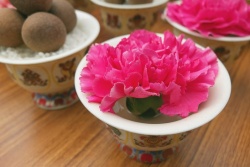Difference between revisions of "Flowers mentioned in the sūtras"
(Created page with "thumb|250px| Flowers mentioned in the sūtras are listed below. A question mark next to the Chinese name of a plant indicates the failure to find its corr...") |
|||
| Line 1: | Line 1: | ||
[[File:134019.jpg|thumb|250px|]] | [[File:134019.jpg|thumb|250px|]] | ||
| − | Flowers mentioned in the sūtras are listed below. A question mark next to the Chinese name of a plant indicates the failure to find its corresponding Sanskrit name. Then a Sanskrit name is constructed phonetically from Chinese. | + | [[Flowers]] mentioned in the sūtras are listed below. A question mark next to the Chinese name of a plant indicates the failure to find its corresponding [[Sanskrit]] name. Then a [[Sanskrit]] name is constructed phonetically from Chinese. |
| + | |||
| + | the lotus which plays a key role, many other flowers are prevalent. Among them are the nilopala which some equate with the blue water lily, and the utpala, a term used for the curly-petaled flower that in the Chinese tradition is a symbol of longevity or renewal -- the peony. However, "utpala" is sometimes taken to mean a lotus, and may also refer to a multi-bloomed flower such as the rhododendron that comes in many colours, or even the anemone. The ashok, which is the rose, also appears. | ||
| + | |||
| + | Mandira blossoms are flowers characteristically offered to deities, perhaps jasmine. | ||
| + | |||
| + | The Udumbara is a mysterious flower that blooms but once every three thousand years. It is used in Buddhist writings to stress the rare preciousness of an event or occasion. | ||
| + | |||
| + | The nomenclature is certainly rather confusing. The flower held by the Taras, and also supporting the book in images of Manjushri, is often referred to as utpala, a frilly blue flower, but the "bud" resembles the pod of a poppy, yet people also call it a lotus. | ||
| + | |||
| + | In traditional Chinese culture (Buddhist and Taoist,) 4 distinct flowers stand for the seasons. The lotus signifies summertime. The China aster, or chrysanthemum indicum, which is a symbol of happiness and prosperity, represents autumn, and the wild plum stands for winter. The peony is the flower of renewal -- spring. | ||
| + | |||
| + | Sharira flowers are mysterious items that appear spontaneously as relics of enlightened beings or at auspicious events. They are of various colours, from sky blue to pink and dark purple. | ||
{{R}} | {{R}} | ||
[http://www.sutrasmantras.info/glossary.html#faculty www.sutrasmantras.info] | [http://www.sutrasmantras.info/glossary.html#faculty www.sutrasmantras.info] | ||
[[Category:Buddhist Terms]] | [[Category:Buddhist Terms]] | ||
[[Category:Flowers]] | [[Category:Flowers]] | ||
Revision as of 03:59, 6 May 2013
Flowers mentioned in the sūtras are listed below. A question mark next to the Chinese name of a plant indicates the failure to find its corresponding Sanskrit name. Then a Sanskrit name is constructed phonetically from Chinese.
the lotus which plays a key role, many other flowers are prevalent. Among them are the nilopala which some equate with the blue water lily, and the utpala, a term used for the curly-petaled flower that in the Chinese tradition is a symbol of longevity or renewal -- the peony. However, "utpala" is sometimes taken to mean a lotus, and may also refer to a multi-bloomed flower such as the rhododendron that comes in many colours, or even the anemone. The ashok, which is the rose, also appears.
Mandira blossoms are flowers characteristically offered to deities, perhaps jasmine.
The Udumbara is a mysterious flower that blooms but once every three thousand years. It is used in Buddhist writings to stress the rare preciousness of an event or occasion.
The nomenclature is certainly rather confusing. The flower held by the Taras, and also supporting the book in images of Manjushri, is often referred to as utpala, a frilly blue flower, but the "bud" resembles the pod of a poppy, yet people also call it a lotus.
In traditional Chinese culture (Buddhist and Taoist,) 4 distinct flowers stand for the seasons. The lotus signifies summertime. The China aster, or chrysanthemum indicum, which is a symbol of happiness and prosperity, represents autumn, and the wild plum stands for winter. The peony is the flower of renewal -- spring.
Sharira flowers are mysterious items that appear spontaneously as relics of enlightened beings or at auspicious events. They are of various colours, from sky blue to pink and dark purple.
